Georgina Campbell's Cookery Feature - Darina Allen's Simply Delicious Christmas
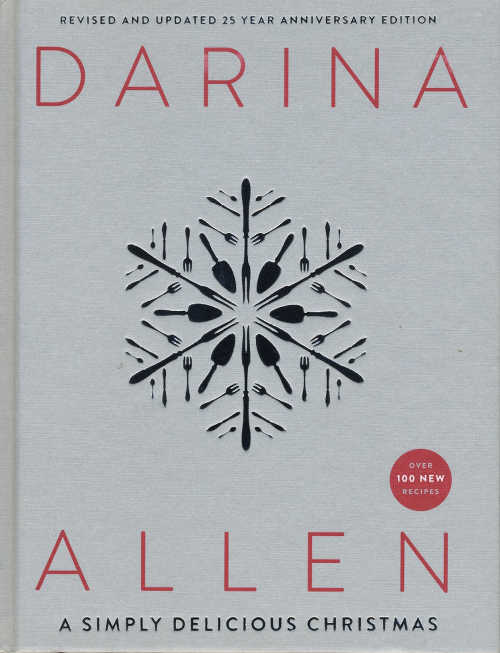 Twenty five years on and the original recipes in Darina Allen’s A Simply Delicious Christmas (Gill & Macmillan, hardback €27.99) still seem as fresh and relevant as ever, but this handsome celebratory edition also includes over a hundred new recipes and many of these are a gentle seasonal reflection of our changing tastes in food.
Twenty five years on and the original recipes in Darina Allen’s A Simply Delicious Christmas (Gill & Macmillan, hardback €27.99) still seem as fresh and relevant as ever, but this handsome celebratory edition also includes over a hundred new recipes and many of these are a gentle seasonal reflection of our changing tastes in food.
All the old favourites that we don’t want to mess with are there, but the difference in this edition is the huge amount of choice. There must be ten ways of cooking turkey, for example, and I’m especially taken with ‘Christmas Dinner on a Dish’, which serves about 30 and seems to be the perfect solution to the age old problem where the cook never gets to enjoy the party, especially as it can even be prepared a week ahead and frozen.
There are plenty of alternative roasts and a terrific range of vegetables and salads. Just thinking about the traditional feast makes me long for light, juicy, colourful dishes and here they are.
You’ll find super starters like salads of Ruby grapefruit, pomegranate and shredded mint, or Watercress, blood orange and Toonsbridge mozzarella, for example and a beautiful Gravlax with cucumber ribbons and mustard and dill mayonnaise.
And, along with traditional puddings, mince pies and trifles to beat the band, there are soothing, refreshing desserts like frosted tangerines, intriguing Turkish delight and rosewater ice cream and a big soothing bowl of Christmas fruit salad.
Then there are edible gifts, traditional sweetmeats and ideas for every possible eventuality on the day and throughout the festive holiday. Younger readers accustomed to expecting an image with every recipe may be surprised that so many do not have photos - just as well as it’s already a big book, running to 362 pages, but in any case the recipes are very clear and reading them without visual prompts activates the imagination, which is always fun.
The recipes given below could make a lovely alternative Christmas dinner for a small adult group who don’t want to take the traditional turkey route, and quantities would easily scale up to feed eight.
RECIPES
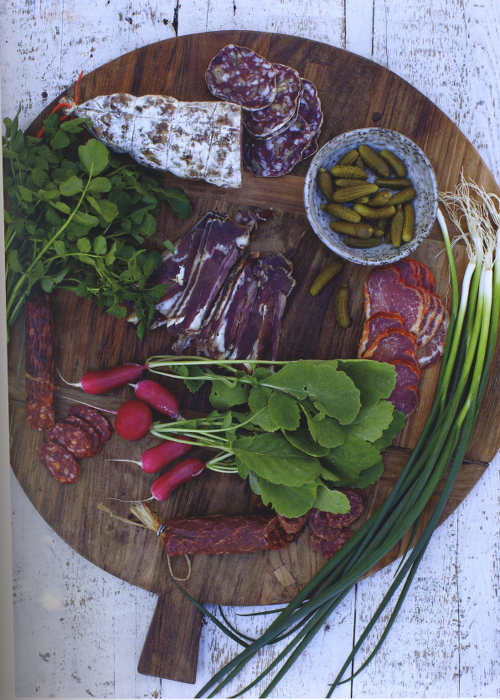 A Plate of Irish Charcuterie and Cured Meats
A Plate of Irish Charcuterie and Cured Meats
One of my favourite easy entertaining tricks is to serve a selection of Irish artisan charcuterie from inspired producers like Fingal Ferguson from Schull, West Cork, James McGeough from Oughterard, Co. Galway, Jack McCarthy from Kanturk, Co. Cork, Patrick Mulcahy from Ballinwillin, Mitchelstown, Co. Cork, and Matthew Conroy from Woodside Farm, Leamlara, Co. Cork. The quality is so wonderful that I'm always bursting with pride as I serve it.
A selection of cured meats:
air-dried smoked Connemara lamb
smoked venison
Gubbeen prosciutto and chorizo
Woodside Farm salami and chorizo
Dunmanus Castle beef salami
pepper and caraway salami
Three Castle pastrami
West Cork kassler
brawn
A selection of:
crusty country breads, sourdough bread, yeast bread and Irish soda bread
tiny gherkins or cornichons
fresh radishes, just trimmed but with some green leaf attached
a good green salad of garden lettuce and salad leaves
Arrange the meats, potted meats and the accompaniments on a large platter, open a good bottle of red and tuck in!
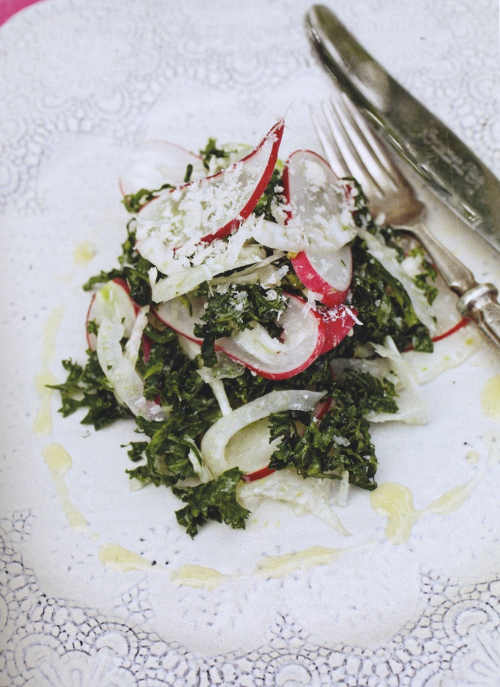 Kale, Fennel, Radish and Parmesan Salad
Kale, Fennel, Radish and Parmesan Salad
So delicious and fresh tasting - the perfect salad for the festive season.
110g (4oz) fennel, thinly sliced
8 radishes (preferably French Breakfast), thinly sliced at
a long angle
150g (5oz) green curly kale, stalks included
3 tablespoons extra virgin olive oil
1 tablespoon lemon juice
4 tablespoons grated Parmesan cheese
salt and freshly ground pepper
Serves 4 as a starter
Keep the sliced fennel and radishes in iced water for at least 5 minutes. Drain well. Remove the stalks from the kale and shred the leaves very finely (discard the stalk).
Put the kale, drained fennel and radishes into a bowl. Drizzle with the extra virgin olive oil and lemon juice. Grate on some Parmesan with a slivery microplane. Season with salt and freshly ground pepper. Toss, taste and serve.
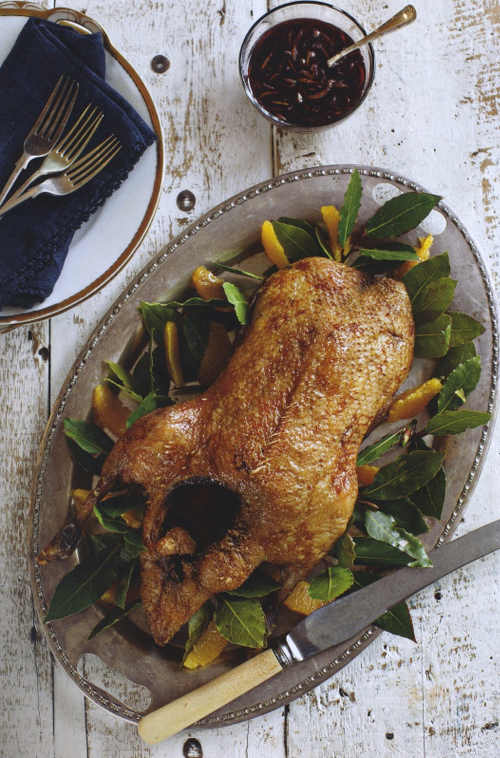 Roast Duck with Orange
Roast Duck with Orange
Labour intensive and expensive, but well worth the effort. This is Rory O'Connell's version of the classic duck with orange
3 brightly coloured organic oranges
1 x 1.8kg (4lb) free-range duck
salt and freshly ground pepper
Sauce
3 tablespoons granulated sugar
70ml (2½ fl oz) red wine vinegar
300ml (½ pint) chicken or duck stock
110ml (4 fl oz) port
70ml (2½ fl oz) red wine
½-1 tablespoon Grand Marnier
a few drops of lemon juice
Garnish
sprigs of watercress or parsley
Serves 4
Preheat the oven to 220°C/425°F/gas mark 7.
Scrub the oranges. Peel the zest from 2 oranges with a swivel top peeler and cut two-thirds into fine julienne strips. Blanch and refresh, (save the skinless oranges.)
Season the duck cavity and the skin with salt and freshly ground pepper. Put the remaining one-third of the orange peel into the cavity and transfer the duck to the hot oven.
Cook for 30 minutes, then reduce the temperature to 180°C/350°F/gas mark 4. Continue to roast for a farther 30-45 minutes. Pour off the duck fat and save for roast potatoes.
While the duck is roasting, make a sweet and sour caramel. Boil the sugar and vinegar over a moderately high heat for several minutes, until the mixture has turned into a rich chestnut brown-coloured syrup. Remove from the heat immediately and pour in 150ml (¼ pint) of the stock.
Simmer for a minute, stirring to dissolve the caramel, then add the rest of the stock, port, wine and the juice of 1 orange. Simmer until the sauce is clear and lightly thickened, then add the orange liqueur little by little. Add the orange julienne.
Taste, correct the seasoning and sharpen with lemon juice if necessary. Leave aside. The sauce may be prepared to this point several hours in advance. Cut the 2 remaining oranges into neat skinless segments and reserve for garnishing the duck.
When the duck is cooked, allow it to rest in a warm oven for at least 10 minutes before carving. Carve neatly and arrange on a serving dish or individual plates. Garnish with the orange segments.
Spoon some of the sauce over the duck and serve the rest separately in a sauce boat. Garnish with sprigs of watercress or parsley.
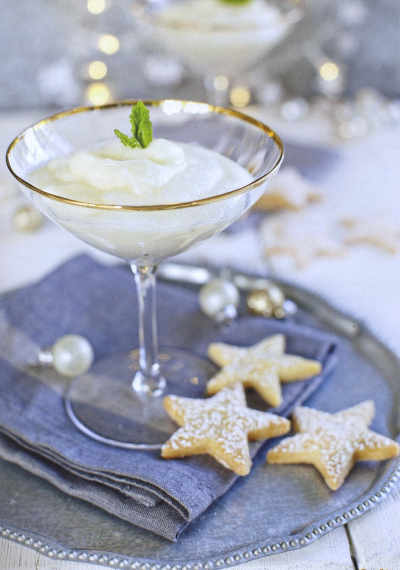 Bramley Apple Snow
Bramley Apple Snow
This is a simple old-fashioned pudding that we absolutely love. It's great with shortbread biscuits or even ladyfingers. It seems particularly appropriate around Christmas.
Serves 6
450g (llb) Bramley's Seedling cooking apples
50g (2oz) approx. sugar
1-2 dessertspoons wafer
1 egg whites, preferably free-range and organic
To serve
Jersey cream
soft brown sugar
shortbread biscuits or ladyfingers (boudoir biscuits)
Peel and core the apples, cut into chunks and put into a saucepan.
Add the sugar and water, cover and cook on a gentle heat, stirring every now and then, until the apples dissolve into a fluff. Rub through a nylon sieve or liquidise. Bramley apples can be very sour at the beginning of the season, so taste and add a little more sugar if it seems too tart.
Whisk the egg whites until stiffly whipped, then fold in gently.
Pour into a pretty glass bowl, pop into the refrigerator and serve well chilled with cream, soft brown sugar and shortbread or ladyfingers.
NOTE: The egg yolks may be used for homemade lemon curd.
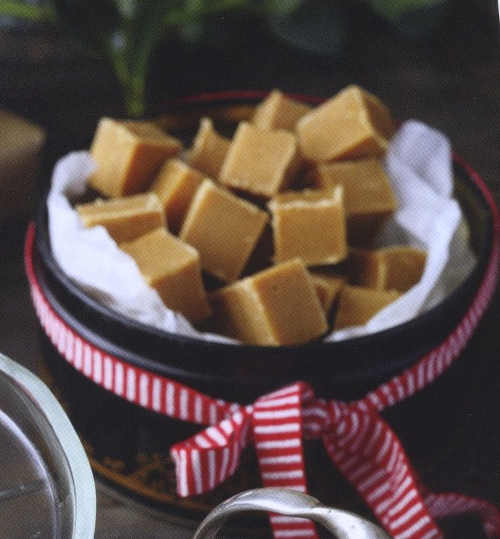 Ballymaloe Fudge
Ballymaloe Fudge
Every time I eat a piece of Fudge, I remember Ivan Alien, my father-in-law - he loved fudge.
225g (8oz) butter
700g (1½ lb) caster sugar
1 x 410g (l4oz) can evaporated milk
200ml (7fl oz) water
1 teaspoon pure vanilla extract
Makes 96 pieces
Melt the butter in a heavy-bottomed saucepan over a low heat. Add the sugar, evaporated milk, water and vanilla extract and stir with a whisk until the sugar is dissolved. Turn up the heat to a simmer and stir constantly until it reaches the soft ball stage - 113°C (235 °F) - which will take approx. 45 minutes.
To test, put some of the fudge in a bowl of cold water - it's ready when a smooth, soft ball forms. When it's ready, pull it off the heat. Stir vigorously until it thickens and reaches the required
consistency: thick and sandy.
Sit the base of the saucepan into a sink of cold water to stop the cooking. Line a 23cm x 33cm (9in x 13in)
Swiss roll tin with parchment or silicone paper and pour in the fudge mixture. Smooth the surface with a spatula. Allow to cool and then cut into squares before it gets completely cold.





There are currently no comments
Leave a comment
Not a member? Register for your free membership now!
Or leave a comment by logging in with: